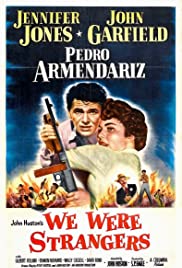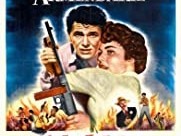We Were Strangers *** (1949, Jennifer Jones, John Garfield, Pedro Armendáriz, Ramon Novarro, Gilbert Roland) – Classic Movie Review 9961
Director John Huston’s 1949 We Were Strangers stars John Garfield as Tony Fenner, who helps a 1930s Cuba plot to overthrow the tyrannical and despotic government of President Machado by blowing up a cemetery at a state funeral.
We Were Strangers is a careful, sombre political adventure with drama and romance in a strongly felt screenplay by Peter Viertel and John Huston that just misses the Ernest Hemingway spot it seems to be seeking.
The romance with Garfield and Jennifer Jones (as China Valdés) is a non-starter (Huston wanted Marilyn Monroe but producer Sam Spiegel held out for Jones), with the duo showing no chemistry. But there is outstanding work from Pedro Armendáriz as police chief Armando Ariete, Ramon Novarro as the rebel chief, and especially Gilbert Roland as the revolutionary Guillermo Montilla.
Those concerned with characterisation, need look no further than the blurb: ‘China Valdés, a woman of violent hates and fierce loves. Tony Fenner, a tough guy with a conscience.’ Well that’s all right then, all pretty straightforward, easy to act and unchallenging to watch.
Based on Robert Sylvester’s novel Rough Sketch, it is one of Huston’s more interesting, least known films.
Wally Cassell, Morris Ankrum, David Bond, Paul Monte, José Pérez, Tito Renaldo, Leonard Strong, and Robert Tafur.
We Were Strangers is directed by John Huston, runs 106 minutes, is made by Horizon Pictures, is released by Columbia Pictures, is written by Peter Viertel and John Huston, based on Robert Sylvester’s novel Rough Sketch, is shot in black and white by Russell Metty, is produced by Sam Spiegel and is scored by Georges Antheil.
It is supposed to be an example of film gris, a sub-category of film noir with a left-wing narrative. It is certainly fascinating as a pro-revolutionary, left-wing Hollywood film, though its theme is the need to the overthrow dictatorships any way necessary, which could be seen simply to reflect what happened in World War Two. It is a complex matter.
It was filmed in Havana, Cuba, for the exteriors only, but there is extensive studio work, with much distracting use of process photography. The actors in the studio emote remotely against images of the location footage. It was usual for Hollywood at the time but it doesn’t wear well.
© Derek Winnert 2020 Classic Movie Review 9961
Check out more reviews on http://derekwinnert.com



